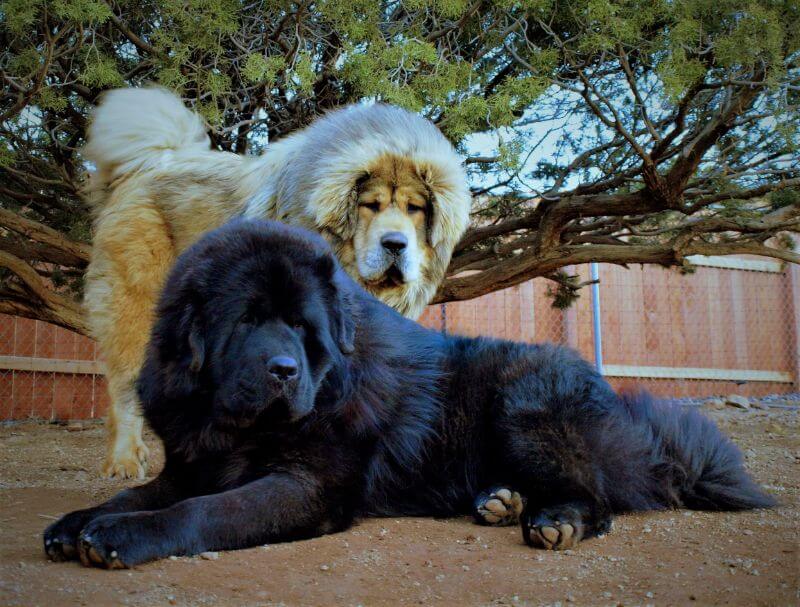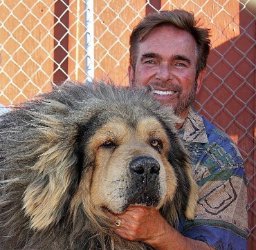When it comes to the Tibetan Mastiff, after silhouette, head type is foremost of the breed-defining traits. Whether a mastiff that evolved as a mountain dog in the harshest of climates and terrains, or a mountain dog of mastiff type and proportions, the classic head types seen on ideal specimens of the breed are a sight to behold. With the varieties of bloodlines from the many diverse Himalayan regions, there can be confusion as to what constitutes the best of, and I dare say, the proper expression as defined by contemporary Tibetan Mastiff Breed Standards.
International Standards describe in detail and prioritize head type in the molosser breeds, and such is certainly the case with the noble Tibetan Mastiff. The broad and massive skull with the solemn yet watchful expression, the wrinkled head, and defined occiput connects to a deeply defined stop. The impressive head is framed with a full, thick, and upstanding mane that becomes more developed in length with age, more so in males, especially those living in colder climates.
When making breeding or judging decisions, a review of the Standard in play is advised to refresh and remind of breed preferences, faults, and disqualifications. It is essential to have a clear and concise image when it comes to what constitutes correct breed type, especially in reference to the Tibetan Mastiff head.
The broad, padded, and square muzzle with thickly developed upper lips cover moderately developed flews and often pendulous lower lips. The expressive almond-shaped eyes are wider and more deeply set, and the medium-sized pendant ears drop forward and hang closer to the head, becoming level with the topskull when alerted. Add to that a fully pigmented, broad nose with open nostrils, and full dentition with a scissors or level bite to complete the picture.
[wonderplugin_3dcarousel id=73]
A correct Tibetan Mastiff comes in a variety of colors, is never refined or generic, and is always profoundly impressive.
When making breeding or judging decisions, a review of the Standard in play is advised to refresh and remind of breed preferences, faults, and disqualifications. It is essential to have a clear and concise image when it comes to what constitutes correct breed type, especially in reference to the Tibetan Mastiff head.
Having begun my journey in the breed in 1978 with my signature DRAKYI line of Tibetan Mastiffs, in the 45 years that have followed I’ve owned, bred, handled, championed, and judged countless Tibetans Mastiffs around the world. Judging record entries of 600 Tibetan Mastiffs in China and 223 at the 2016 World Dog Show in Moscow are highlights I will never forget. I find that photos are certainly worth those thousand words, so I have included examples of dogs I have owned, bred, and/or judged that I find to best embody the breed ideal.
When judging the breed, don’t put a premium on showiness and don’t be surprised if the dog doesn’t even raise an indifferent eyebrow to show expression (unless a squirrel races through the ring!). The Tibetan Mastiff would much prefer being at home guarding the property while the people go to the dog show. Let the handler show the bite, unless permission is given. Prioritize sound, purposeful movement and classic head type, as described above. A correct Tibetan Mastiff comes in a variety of colors, is never refined or generic, and is always profoundly impressive.
Tibetan Mastiff Breed Magazine
Showsight Magazine is the only publication to offer dedicated Digital Breed Magazines for ALL recognized AKC Breeds.
Read and learn more about the Tibetan Mastiff dog breed with articles and information in our Tibetan Mastiff Breed Magazine.
Error embedding FlippingBook shortcode, please check the flipbook url. (https://digital.showsightmagazine.com/view/957454/)
If you enjoy the Tibetan Mastiff Breed Magazine, help us educate the community by sharing it.









